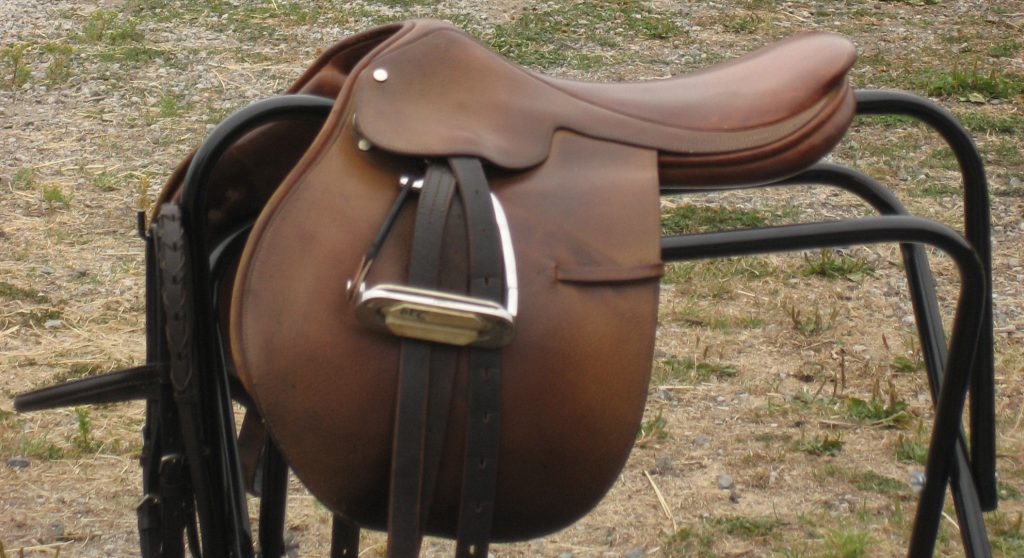Horsemanship Level 4: Saddlery pt I
The final checklist item for Horsemanship 4 is:
10. Saddlery. Fit and care of own tack. Identify & fit nosebands, girths & common tack. Put on & remove a blanket.
Once more, this is a large topic that we'll break down into several posts, looking at saddle fitting this week.
Fitting the Saddle
A saddle that fits your horse correctly is vital. Saddles which fit poorly can impinge on a horse's movement, pinch, rub, or create pressure points that will at the minimum be uncomfortable, and at the worst cause sores, back problems, or lameness. Bump-up pads or shims can ameliorate a poor fit, but in the long run you will need a saddle that fits the horse properly.
To check your saddle fit, place it on the horse's back without a saddle pad.
 Tree width. If the saddle tree is too wide it will press on the horse's withers. If it is too narrow it will perch on top and pinch the withers. A saddle may have a wide gullet but a steep angle or vice versa. Read this blog post by professional saddler Jochen Schleese for a more in depth look at width and angle.
Tree width. If the saddle tree is too wide it will press on the horse's withers. If it is too narrow it will perch on top and pinch the withers. A saddle may have a wide gullet but a steep angle or vice versa. Read this blog post by professional saddler Jochen Schleese for a more in depth look at width and angle.- Shoulder. Run your hand down your horse's shoulder between him and the saddle. If you feel the saddle is tighter in some spots than the other it will impinge or put pressure points on his shoulder. A horse with a steep shoulder may require a saddle with a less forward cut flap, and some steep-shouldered horses can't wear jumping saddles at all.
- Gullet. You should be able to see daylight when you look down the channel along the horse's spine, ensuring there is clearance along the length of the saddle.

- Seat length. The back of the saddle should put weight on the horse's loins. If you require a large seat, you may not be able to ride a short-backed horse for this reason.
- Level seat. To check that the saddle sits level, place a pencil in the deepest part of the seat. It should not roll forward or backward. In a general purpose saddle cantle and pommel should be level with one another (stock saddles, mediaeval saddles and other specialty saddles may have varying cantle and pommel heights, but the seat should still be level).
- Panels. The panel stuffing should be level on both sides so the saddle sits straight when viewed from behind. If your horse has an uneven back you may need to get the saddle stuffed specially to level it out.
- Bridging. Run your hand along the panel from front to back check for uneven pressure. A saddle that 'bridges' or touches the back only at the front and back, but not the middle of the panels, will put too much pressure on those points.
Next, girth up and have someone mount the horse.
- Look from the back to see the saddle is still straight and not putting the rider out of balance or shifting sideways on the back.
- There should still be space for two fingers between the top of the horse's withers and the saddle.

Have the rider walk, trot, and canter to ensure that:
- The shoulders can move freely without interference from the saddle.
- The seat stays level, and the rider does not slide forward or backward.
- The saddle does not slip forward or backward. Fat ponies may need a crupper to keep the saddle from sliding forward, and some horses will need a breastplate for jumping, but ideally the saddle should stay in place on its own.
When a horse loses or gains weight, the saddle fit will change. It's better to switch saddles if your horse has put on weight rather than risk spreading the tree of the saddle. A professional saddle fitter may be able to alter your saddle to fit the horse, or if necessary, create a custom saddle for you and your horse.
Upcoming Classes
Friday Clinic: Prix Fiore
 In our last Friday clinic for the summer we will work on drill team patterns, pas-de-deux, and team jumping with sword in hand.
In our last Friday clinic for the summer we will work on drill team patterns, pas-de-deux, and team jumping with sword in hand.
Instructor: Jennifer Landels
Prerequisite: Riding Level 1 or equivalent
Prix Fiore: July 15th
cost: $60 +gst
Riding & Horsemanship Classes
Riding & Horsemanship classes run in 6 week series. There is drop-in space in the current Monday evening series, and registration is open for the upcoming Saturday series.
Mondays 13 Jun – 18 Jul
Saturdays 16 Jul – 20 Aug
Mondays/Thursdays 22 Aug – 8 Sep
Horseback Archery
Robert Borsos will be back on July 17th for another fabulous day of Horseback Archery. No experience, either with horses or bows, is needed for the beginner workshop. For the intermediate workshop riders should have their Riding Level 1 and have taken the beginner workshop. This is the last workshop before Carosella and they tend to fill up, so sign up soon!
Beginner: Sunday 17 July, 10am – 1pm
Intermediate: Sunday 17 July, 2pm – 5pm
Carosella 2016
Three fabulous days of Mounted Combat, Archery and Games! The dates have been set for September 9th – 11th. Registration isn’t yet open, but you can look at last year’s schedule to get an idea of what’s on offer, and start planning your training now.

